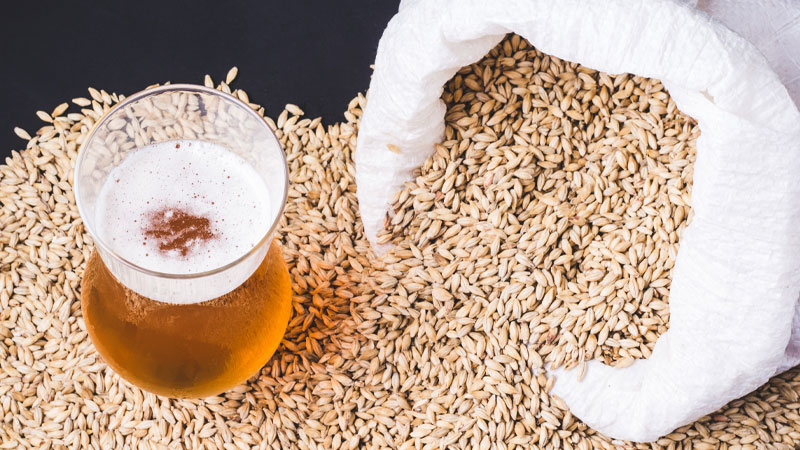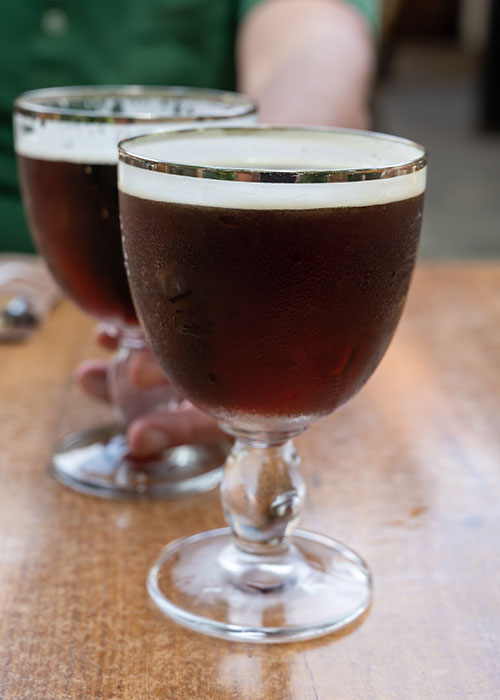Belgian beers are known for a bouquet of aromas featuring many complex layers of fruits, toast, baking spices, and candy. These varied flavors give the impression of a complicated recipe composed of many ingredients, but they’re in fact all thanks to one ingredient: Belgian yeast. These warm-fermenting yeast strains are tricky devils that hold the key to intricate flavors in their very nature.
Because the yeast does most of the flavor lifting in Belgians, the rest of the recipe can be fairly straightforward. In fact, many of the classic Belgian beers admired around the world can be mimicked using just one malt, one sugar source, a little wheat or oats for protein, and a single variety of hops, topped off with a healthy pitch of that recognizable Belgian yeast.
To make things even easier for brewers who might not have temperature-controlled fermentation set up at home (yet!), Belgian yeast can ferment happily at room temperature (typically in a range of 68-75 degrees Fahrenheit).
And now, let us commence upon the adventure that is deciding on, brewing, fermenting, and raising a toast to this deceptively simple Belgian brew.
The Basics
Below is a recipe to which brewers can make minimal adjustments for successful versions of four classic Belgian styles: Dubbel, Tripel, Dark Strong, or Golden Strong. According to The Beer Judge Certification Program (BJCP) guidelines, each of these styles would be within the acceptable range of the style with a finishing gravity (FG) of 1.01 and about 22 international bittering units (IBUs). That’s exactly where this recipe starts.
The Basic Belgian Homebrew Recipe
Makes 5 gallons
- 10 pounds Belgian pilsner malt
- 1 pound flaked oats or flaked wheat (or 8 ounces of each if you just can’t help being complicated)
- ⅕ pound specialty malt, depending on the chosen style
- 1-3 pounds sugar, depending on the chosen style
- ½ ounce high alpha hops [10-14 percent Alpha Acid (AA)] or 2 ounces low alpha hops (2-5 percent AA) added at 60 minutes
- 1 ounce Saaz or Styrian Goldings hops added at 5 minutes
- Optional: 1 ounce Saaz or Styrian Goldings hops added at 2 minutes
- ¾ teaspoon (about 3 grams) yeast nutrient
- Yeast, depending on chosen style and fermentation environment
Pilsner malt is important to these Belgian styles because its light flavor imparts the crisp, snappy mouthfeel that is signature to Belgian beers. Two-row or Belgian pale malt can be substituted here, but especially in the lighter styles (Tripel and Golden Strong), some cracker or pizza crust notes may come through in the finished beer.
The flaked oats or flaked wheat are there to contribute protein and help the formation of the massive, moussy froth that is expected atop Belgian ales. Beer head is a complicated phenomenon, but at its most basic level, malt proteins and hop compounds form a net-like structure around escaping CO2 bubbles and hold them at the top of the beer. No protein means no net, which means no head. Oats or wheat are therefore necessary to provide that bit of head retention boost.
The next ingredients depend on which style you’d like to brew.
Belgian Dubbel
A solid Belgian Dubbel should have flavors of dark and light fruits, a hint of toast, and a note of caramel. These flavors, especially the fruit-forward ones, are achieved through the unique fermentation profile of Belgian yeast. But a touch of Belgian Special B malt contributes prune and dried fig flavors, while a healthy dose of amber Candi Syrup takes care of the caramel notes. Belgian Candi Sugar is one of the pricier homebrew ingredients, so if you’d like to use the whole 1-pound package in this batch, go for it. Just know that it will push the alcohol by volume (ABV) of this recipe to 7.8 percent, which is just outside of the BJCP’s stated range for the style.
Belgian Dubbel Adjustments to the Basic Belgian Homebrew Recipe
- Specialty malt: ½ pound Special B
- Sugar: ¾ pound amber Belgian Candi Syrup
- Yeast: Belgian abbey ale
Belgian Tripel
Belgian Tripels have all the fruit notes found in Dubbels with none of the toast or caramel flavors that could obscure the subtle spice notes created by the yeast. An extra dose of herbal and earthy Saaz hops accentuates that kick from the yeast.
The best Tripels have a slightly round impression without being sweet, which is achieved nicely through the golden Candi Syrup. Aromatic malt provides a hint of just-baked biscuit flavor to balance the yeast character.
Belgian Tripel Adjustments to the Basic Belgian Homebrew Recipe
- Specialty malt: ½ pound aromatic malt
- Sugar: 1 pound Golden Belgian Candi Syrup
- Add the Optional ounce Hops
- Yeast: Belgian Abbey ale (Wyeast 3787 is a classic choice)
Belgian Dark Strong
These dark, rich beers display lots of dried fruit character and a dark toffee or fruit cake note that makes a cozy complement to their elevated alcohol (this one lands right around 10 percent). Using Special B malt takes care of sticky dried fruit flavors, and two types of Candi sugar ensure a dark color with plenty of toffee and caramel notes. Then, add in a yeast that can handle high gravity to produce raisin, pear, and baking spice flavors.
Belgian Dark Strong Adjustments to the Basic Belgian Homebrew Recipe
- Specialty Malt: ½ pound Special B
- Sugar: 1 pound D-90 Candi Syrup and 1 pound D-45 Candi Syrup
- Optional: Hops
- Yeast: White Labs 540 (if you don’t have temperature control, use Wyeast 1214 or similar)
Belgian Golden Strong
The most iconic example of this style is Duvel; the name says it all. This high-alcohol style is dangerously drinkable because of its dry finish and simple recipe. It’s all about crisp apple and underripe pear notes from the yeast and ultra-high carbonation to keep it light on the palate. A whopping 2-and-a-half pounds of sugar contributes no additional flavor but dries out the body of the beer and keeps its color as light as Champagne.
Belgian Golden Strong Adjustments to the Basic Belgian Homebrew Recipe
- Specialty Malt: None
- Sugar: 2 ½ pounds table sugar (sucrose) made into a syrup by warming it with a little water on the stovetop
- Optional: 1 ounce hops
- Yeast: Belgian Strong Ale (Wyeast 1388 is a good one!)
Fermentation and Adding Sugar
Ideally, these beers will be chilled down to 60-63 F when yeast is pitched (the cooler the better). Once there is lively activity in the airlock, the temperature can be ramped up 1-2 degrees F each day until it reaches 68-70 F. If you don’t have equipment to control the temperature of your fermentation, simply find the coolest place in your home to ferment. Preferably, the space will also be dark, as covering the fermenter block light would add undesirable insulation.
Allow fermentation to continue until just after high krausen (this is the stage of fermentation when there is the most yeast activity; you’ll notice lots of bubbling in the airlock and foaming at the top of the beer). If you’ve brewed a couple of times before, you know what this looks like. For newer homebrewers, this stage typically occurs around day five or six.
Waiting until yeast activity has started to die down to add more fermentables is a good move in Belgian styles for two reasons: First, it ensures yeast goes to work on all of the fermentables provided by malt first. If yeast are given a large amount of simple (easy to digest) sugars up front, they may become too overwhelmed or too lethargic to finish consuming other fermentables, leaving behind a Belgian beer that’s a little flabby and heavy instead of light and snappy. Second, these Belgian strains produce all kinds of flavors including green apple, zesty white pepper, and sweet banana during fermentation. When given a dose of sugar, especially at a warm fermentation temperature, they can go into flavor production overdrive creating so many spicy phenols and fruity esters that the flavors turn overwhelming like rubbery Band-Aid or solvent-like nail polish. Feeding them in steps keeps the activity consistent and the flavor in check.
To add the sugar, soak the bag of Candi sugar in hot water for a few minutes; this will loosen the syrup so it pours easily into the fermenter. Be sure to sanitize the mouth of the syrup bag, then open the fermenter, allowing as little oxygen exposure as possible. Pour in the contents of the bag just vigorously enough to mix the syrup into the wort but without splashing.
For Belgian Dark Strong and Belgian Golden Strong beers, just add the first pound of sugar, then come back two or three days later to add the rest.
Carbonation Level
One of the most important aspects of Belgian beer is the carbonation level, which is expected to be shimmering and effervescent with a prickly mouthfeel from lively CO2. Even the best-brewed Belgian beers won’t seem quite right without oodles of bubbles. We’re looking for at least 3.2 volumes of CO2, and more if your bottles can handle it. For context, standard American ales are carbonated to 2.5 volumes. For that reason, these styles are hard to serve out of kegs unless you have special equipment. The best bet is to use the thick glass bottles made specifically for Belgian beers.
Use a calculator like this to figure out the right amount of priming sugar to use for bottle conditioning to 3.2 volumes of CO2 (or higher if you have bottles that can handle it).
After about a month of conditioning at room temperature, pop a bottle into the refrigerator for a full 24 hours, then give it a taste. If there are abundant bubbles, then it’s time to celebrate. If not, allow the bottles to condition for an additional week before sampling again. Once the carbonation is right, your Belgian brewing adventure is complete. See what you think and make tweaks to the recipe to meet your personal preferences for bitterness, alcohol strength, and color. Or, try a new style each time; there is no shortage of adventurous paths to take.


